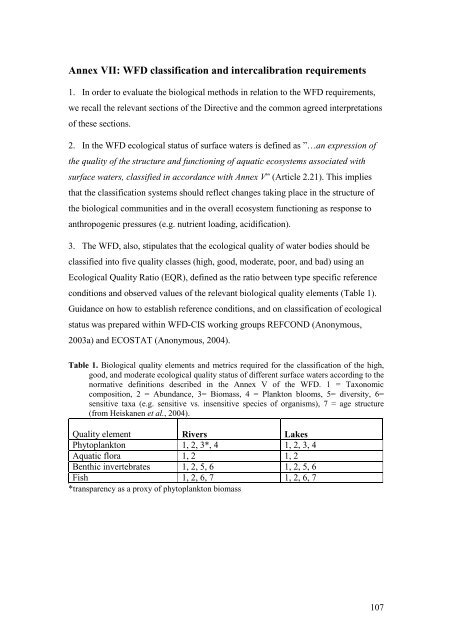Report on Harmonisation of freshwater biological methods
Report on Harmonisation of freshwater biological methods
Report on Harmonisation of freshwater biological methods
You also want an ePaper? Increase the reach of your titles
YUMPU automatically turns print PDFs into web optimized ePapers that Google loves.
Annex VII: WFD classificati<strong>on</strong> and intercalibrati<strong>on</strong> requirements1. In order to evaluate the <strong>biological</strong> <strong>methods</strong> in relati<strong>on</strong> to the WFD requirements,we recall the relevant secti<strong>on</strong>s <strong>of</strong> the Directive and the comm<strong>on</strong> agreed interpretati<strong>on</strong>s<strong>of</strong> these secti<strong>on</strong>s.2. In the WFD ecological status <strong>of</strong> surface waters is defined as ”…an expressi<strong>on</strong> <strong>of</strong>the quality <strong>of</strong> the structure and functi<strong>on</strong>ing <strong>of</strong> aquatic ecosystems associated withsurface waters, classified in accordance with Annex V” (Article 2.21). This impliesthat the classificati<strong>on</strong> systems should reflect changes taking place in the structure <strong>of</strong>the <strong>biological</strong> communities and in the overall ecosystem functi<strong>on</strong>ing as resp<strong>on</strong>se toanthropogenic pressures (e.g. nutrient loading, acidificati<strong>on</strong>).3. The WFD, also, stipulates that the ecological quality <strong>of</strong> water bodies should beclassified into five quality classes (high, good, moderate, poor, and bad) using anEcological Quality Ratio (EQR), defined as the ratio between type specific referencec<strong>on</strong>diti<strong>on</strong>s and observed values <strong>of</strong> the relevant <strong>biological</strong> quality elements (Table 1).Guidance <strong>on</strong> how to establish reference c<strong>on</strong>diti<strong>on</strong>s, and <strong>on</strong> classificati<strong>on</strong> <strong>of</strong> ecologicalstatus was prepared within WFD-CIS working groups REFCOND (An<strong>on</strong>ymous,2003a) and ECOSTAT (An<strong>on</strong>ymous, 2004).Table 1. Biological quality elements and metrics required for the classificati<strong>on</strong> <strong>of</strong> the high,good, and moderate ecological quality status <strong>of</strong> different surface waters according to thenormative definiti<strong>on</strong>s described in the Annex V <strong>of</strong> the WFD. 1 = Tax<strong>on</strong>omiccompositi<strong>on</strong>, 2 = Abundance, 3= Biomass, 4 = Plankt<strong>on</strong> blooms, 5= diversity, 6=sensitive taxa (e.g. sensitive vs. insensitive species <strong>of</strong> organisms), 7 = age structure(from Heiskanen et al., 2004).Quality element Rivers LakesPhytoplankt<strong>on</strong> 1, 2, 3*, 4 1, 2, 3, 4Aquatic flora 1, 2 1, 2Benthic invertebrates 1, 2, 5, 6 1, 2, 5, 6Fish 1, 2, 6, 7 1, 2, 6, 7*transparency as a proxy <strong>of</strong> phytoplankt<strong>on</strong> biomass107














![Accommodation booking form [PDF]](https://img.yumpu.com/39471785/1/184x260/accommodation-booking-form-pdf.jpg?quality=85)

